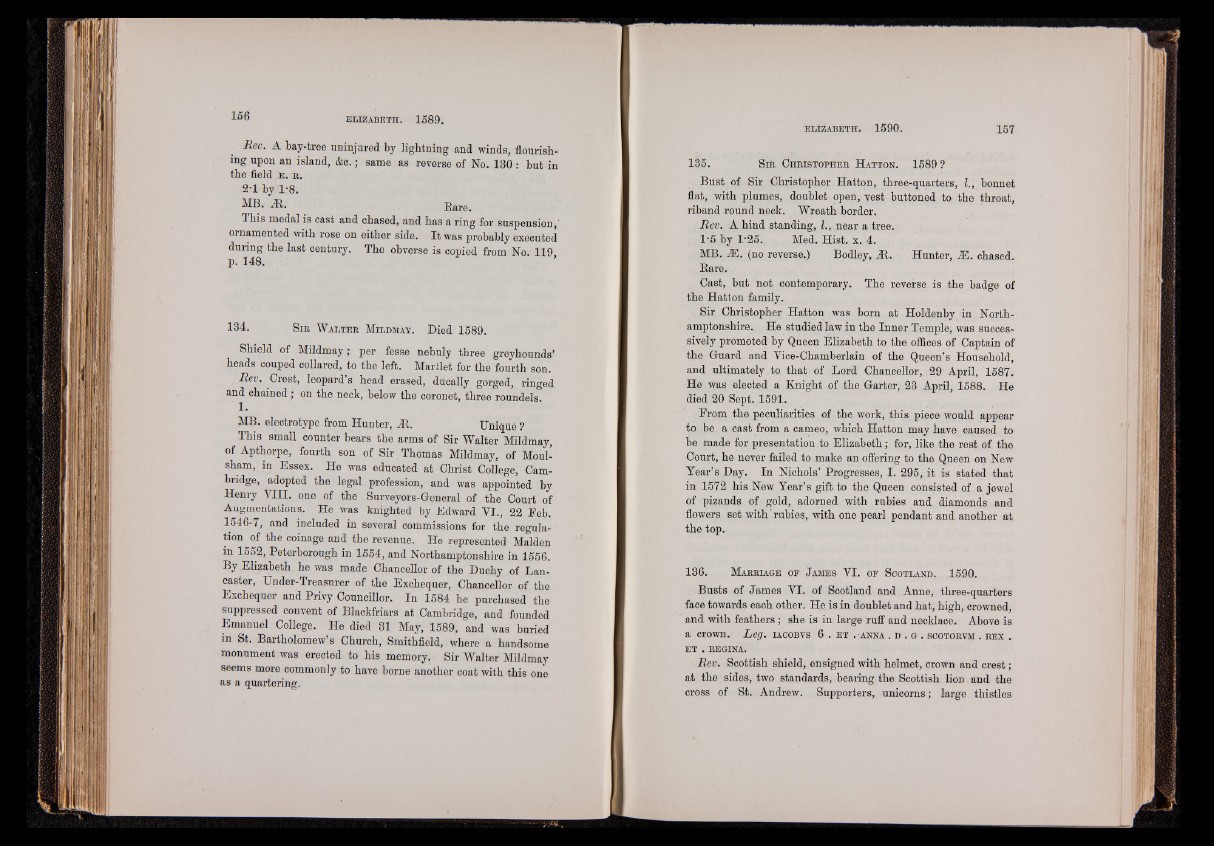
liev. A bay-tree uninjured by lightning and winds, flourishing
upon an island, &c.; same as reverse of No. 130 : but in
the field e . e .
2-1 by 1-8.
MB- Rare.
This medal is cast and chased, and has a ring for suspension,
ornamented with rose on either side. It was probably executed
during the last century. The obverse is copied from No 119
p. 148. ’
134. S ib W a l t e e M i ld m a y . Died 1589.
Shield of Mildmay; per fesse nebuly three greyhounds’
heads couped collared, to the left. Martlet for the fourth son.
Rev. Crest, leopard’s head erased, ducally gorged, ringed
and chained ; on the neck, below the coronet, three roundels
1 .
MB. electrotype from Hunter, At. Unique ?
This small counter bears the arms of Sir Walter Mildmay,
of Apthorpe, fourth son of Sir Thomas Mildmay, of Moul-
sham, in Essex. He was educated at Christ College, Cambridge,
adopted the legal profession, and was appointed by
Henry VIII. one of the Surveyors-General of the Court of
Augmentations. He was knighted by Edward VI., 22 Feb.
1546-7, and included in several commissions for the regulation
of the coinage and the revenue. He represented Malden
in 1552, Peterborough in 1554, and Northamptonshire in 1556.
By Elizabeth he was made Chancellor of the Duchy of Lancaster,
Under-Treasurer of the Exchequer, Chancellor of the
Exchequer and Privy Councillor. In 1584 he purchased the
suppressed convent of Blackfriars at Cambridge, and founded
Emanuel College. He died 31 May, 1589, and was buried
in St. Bartholomew’s Church, Smithfield, where a handsome
monument was erected to his memory. Sir Walter Mildmay
seems more commonly to have borne another coat with this one
as a quartering.
135. S ib C h e i s t o p h e b H a t t o n . 1589?
Bust of Sir Christopher Hatton, three-quarters, I., bonnet
flat, with plumes, doublet open, vest buttoned to the throat,
riband round neck. Wreath border.
Rev. A hind standing, I., near a tree.
1-5 by 1-25. Med. Hist. x. 4.
MB. M. (no reverse.) Bodley, At. Hunter, M. chased.
Rare.
Cast, but not contemporary. The reverse is the badge of
the Hatton family.
Sir Christopher Hatton was born at Holdenby in Northamptonshire.
He studied law in the Inner Temple, was successively
promoted by Queen Elizabeth to the offices of Captain of
the Guard and Vice-Chamberlain of the Queen’s Household,
and ultimately to that of Lord Chancellor, 29 April, 1587.
He was elected a Knight of the Garter, 23 April, 1588. He
died 20 Sept. 1591.
From the peculiarities of the work, this piece would appear
to he a cast from a cameo, which Hatton may have caused to
be made for presentation to Elizabeth; for, like the rest of the
Court, he never failed to make an offering to the Queen on New
Year’s Day. In Nichols’ Progresses, I. 295, it is stated that
in 1572 his New Year’s gift to the Queen consisted of a jewel
of pizands of gold, adorned with rubies and diamonds and
flowers set with' rubies, with one pearl pendant and another at
the top.
136. M a e e i a g e o f J a m e s VI. o f S c o t l a n d . 1590.
Busts of James VI. of Scotland and Anne, three-quarters
face towards each other. He is in doublet and hat, high, crowned,
and with feathers; she is in large ruff and necklace. Above is
a crown. Leg. i a c o b v s 6 . e t . a n n a . d . g . s c o to e v m . e e x .
ET . EEGINA.
Rev. Scottish shield, en signed with helmet, crown and crest ;
at the sides, two standards, bearing the Scottish lion and the
cross of St. Andrew. Supporters, unicorns; large thistles